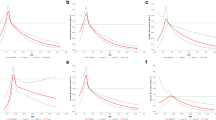Abstract
Objective:
To determine the relationship of body mass index (BMI) and BMI changes during adulthood to lung cancer mortality in a large-sized Japanese cohort.
Methods:
We followed 29,350 men for a maximum of 11 years in the Japan Collaborative Cohort Study for Evaluation of Cancer Risk (JACC Study), which was initiated from 1988 to 1990. Complementary log–log modeling was employed with age, smoking status, and family history of lung cancer as covariates. Anthropometric measurements used were BMI at baseline, BMI around age 20, and adulthood BMI loss defined between the two measurements. Independent effects of these three measurements on lung cancer mortality were evaluated by applying the method of generalized estimation equations to the model for adjustment of intra-individual correlation.
Results:
Never smokers showed that high BMI both at baseline and around age 20 significantly predict lung cancer mortality (P < 0.05). Adulthood BMI loss significantly (P < 0.05) elevated the risk for lung cancer mortality among current smokers, implying their enhanced vulnerability to lung cancer risk among smokers.
Conclusions:
The risk for lung cancer mortality is elevated by a mechanism related to smoking-induced weight loss during adulthood.
Similar content being viewed by others
Abbreviations
- BMI:
-
Body mass index
- ICD:
-
International classification of diseases
- GEE:
-
Generalized estimating equations
- RR:
-
Relative risk
- CI:
-
Confidence interval
- CVD:
-
Cardiovascular disease
References
Hoffmanns MDAF, Kromhout D, De Lezenne Coulander C (1998) Body mass index at the age 18 and its effects on 32-year-mortality from coronary heart disease and cancer. J Clin Epidemiol 42:513–520
Calle EE, Thun MJ, Petrelli JM, Rodriguez C, Heath Jr CW (1999) Body-mass index and mortality in a prospective cohort of US adults N Engl J Med 341:1097–1105
Nomura A, Heibrun LK, Stemmermann GN (1985) Body mass index as a predictor of cancer in men. J Natl Cancer Inst 74:319–323
Seidell JC, Veschuren WM, van Leer EM, Kromhout D (1996) Overweight, underweight, and mortality—a prospective study of 48,287 men and women. Arch Intern Med 156:958–963
Kark JD, Yaari SY, Rasooly I, Goldbourt U (1995) Are lean smokers at increased risk of lung cancer? The Islaeli Civil Servant Cancer Study. Arch Intern Med 155:2409–2416
Goodman MT, Wilkens LR (1993) Relation of body size and the risk of lung cancer. Nutr Cancer 20:179–186
Rauscher GH, Mayne ST, Janerich DT (2000) Relation between body mass index and lung cancer risk in men and women never and former smokers. Am J Epidemiol 152:506–513
Hinds MW, Stemmermann GN, Yang HY, Kolonel LN, Lee J, Wegner E (1981) Differences in lung cancer risk from smoking among Japanese, Chinese and Hawaiian women in Hawaii. Int J Cancer 27:297–302
Ohno Y, Tamakoshi A, The JACC Study Group (2001) Japan Collaborative Cohort Study for evaluation of cancer risk sponsored by Monbusho (JACC Study). J Epidemiol 11:144–150
Allison PD (2001) Survival analysis using the SAS system: a practical guide SAS Institute Inc., Cary, NC
Allison PD (1999) Logistic regression using the SAS system: theory and application SAS Institute Inc, Cary, NC
Hanley JA, Negassa A, Edwardes MD, Forrester JE (2003) Statistical analysis of correlated data using generalized estimating equations: an orientation. Am J Epidemiol 157:364–375
Gamayunova VB, Bobrov YF, Tsyrlina EV, Evtushenko TP, Berstein LM (1997) Comparative study of blood insulin levels in breast and endometrial cancer patients. Neoplasma 44:123–126
Tripkovic I, Tripkovic A, Ivanisevic Z, Capkun V, Zekan L (2004) Insulin increase in colon cancerogenesis: a case–control study. Arch Med Res 35:215–219
Boyd DB (2003) Insulin and cancer. Integr Cancer Ther 2:315–329
Shimokata H, Tobin JD, Muller DC, Elahi D, Coon PJ, Andres R (1989) Studies in the distribution of body fat: I. Effects of age, sex, and obesity. J Gerontol 44:66–73
Ross R, Rissanen J, Hudson R (1996) Sensitivity associated with the identification of visceral adipose tissue levels using waist circumference in men and women: effects of weight loss. Int J Obes Relat Metab Disord 20:533–538
Rosengren A, Wedel H, Wilhelmsen L (1999) Body weight and weight gain during adult life in men in relation to coronary heart disease and mortality. A prospective population study. Eur Heart J 20:269–277
Stevens J, Keil JE, Waid LR, Gazes PC (1990) Accuracy of current, 4-year, and 28-year self-reported body weight in an elderly population. Am J Epidemiol 132:1156–1163
Tamakoshi K, Yatsuya H, Kondo T, et al (2003) The accuracy of long-term recall of past body weight in Japanese adult men. Int J Obesity 27:247–252
Acknowledgments
The authors wish to express their appreciation to Dr. Kunio Aoki, Professor Emeritus, Nagoya University School of Medicine and former chairman of the JACC Study Group, and to Dr. Haruo Sugano, former Director of the Cancer Institute of Japanese Foundation for Cancer Research, both of whom greatly contributed to the initiation of this study. This work was supported by a Grant-in-Aid for Scientific Research on Priority Areas (C)(2) (No. 12218216) from the Ministry of Education, Culture, Sports, Science and Technology of Japan. The JACC Study was also supported by Grants-in-Aid for Scientific Research from the same Ministry (Nos. 63010074, 1010068, 2151065, 3151064, 4151063, 5151069, 6279102 and 11181101).
Author information
Authors and Affiliations
Corresponding author
Rights and permissions
About this article
Cite this article
Kondo, T., Hori, Y., Yatsuya, H. et al. Lung cancer mortality and body mass index in a Japanese cohort: findings from the Japan Collaborative Cohort Study (JACC Study). Cancer Causes Control 18, 229–234 (2007). https://doi.org/10.1007/s10552-006-0069-8
Received:
Accepted:
Published:
Issue Date:
DOI: https://doi.org/10.1007/s10552-006-0069-8




